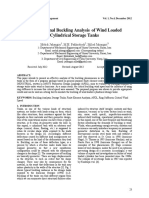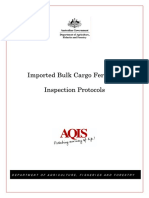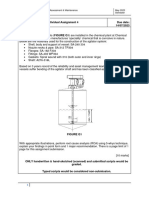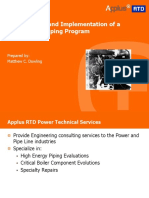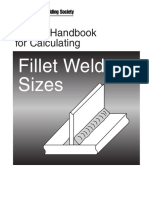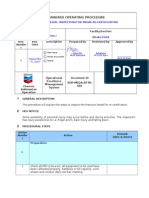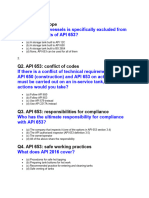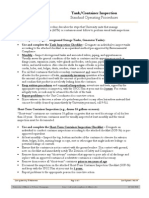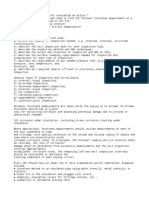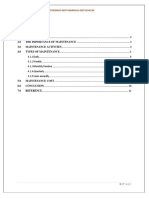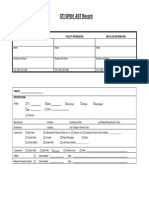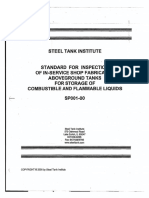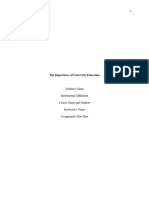STI SP001 AST Record
OWNER INFORMATION
FACILITY INFORMATION
INSTALLER INFORMATION
Name
Name
Name
Number and Street
Number and Street
Number and Street
City, State, Zip Code
City, State, Zip Code
City, State, Zip Code
TANK ID
SPECIFICATION:
Design:
UL
SWRI
API
Other
Horizontal
Vertical
Rectangular
Unknown
Manufacturer:
Contents:
Construction Date:
Dimensions:
Capacity:
Last Change of Service Date:
Construction:
Containment:
Bare Steel
Cathodically Protected (Check one: A.
Coated Steel
Concrete
Plastic/Fiberglass
Double-Bottom
Double-Wall
Lined Date Installed: _______________
Earthen Dike
Steel Dike
Concrete
Synthetic Liner
CRDM:
Date Installed:
Type:
Release Prevention Barrier:
Date Installed:
Type:
AST INSPECTION STANDARD
COPYRIGHT 2011 Steel Tank Institute
Galvanic or B.
Last Repair/Reconstruction Date:
Impressed Current) Date Installed: _______________
Other
Other
SEPTEMBER 2011
�TANK ID
SPECIFICATION:
Design:
UL
SWRI
API
Other
Horizontal
Vertical
Rectangular
Unknown
Manufacturer:
Contents:
Construction Date:
Dimensions:
Capacity:
Last Change of Service Date:
Construction:
Containment:
Last Repair/Reconstruction Date:
Bare Steel
Cathodically Protected (Check one: A.
Coated Steel
Concrete
Plastic/Fiberglass
Double-Bottom
Double-Wall
Lined Date Installed: _______________
Earthen Dike
Steel Dike
Concrete
Galvanic or B.
Synthetic Liner
CRDM:
Date Installed:
Type:
Release Prevention Barrier:
Date Installed:
Type:
Impressed Current) Date Installed: _______________
Other
Other
TANK ID
SPECIFICATION:
Design:
UL
SWRI
Horizontal
Vertical
Rectangular
API
Unknown
Other
Manufacturer:
Contents:
Construction Date:
Dimensions:
Capacity:
Last Change of Service Date:
Construction:
Containment:
Bare Steel
Cathodically Protected (Check one: A.
Coated Steel
Concrete
Plastic/Fiberglass
Double-Bottom
Double-Wall
Lined Date Installed: _______________
Earthen Dike
Steel Dike
Concrete
Synthetic Liner
CRDM:
Date Installed:
Type:
Release Prevention Barrier:
Date Installed:
Type:
AST INSPECTION STANDARD
COPYRIGHT 2011 Steel Tank Institute
Galvanic or B.
Last Repair/Reconstruction Date:
Impressed Current) Date Installed: _______________
Other
Other
SEPTEMBER 2011
�TANK ID
SPECIFICATION:
Design:
UL
SWRI
Horizontal
Vertical
Rectangular
API
Unknown
Other
Manufacturer:
Contents:
Construction Date:
Dimensions:
Capacity:
Last Change of Service Date:
Construction:
Containment:
Last Repair/Reconstruction Date:
Bare Steel
Cathodically Protected (Check one: A.
Coated Steel
Concrete
Plastic/Fiberglass
Double-Bottom
Double-Wall
Lined Date Installed: _______________
Earthen Dike
Steel Dike
Concrete
Galvanic or B.
Synthetic Liner
CRDM:
Date Installed:
Type:
Release Prevention Barrier:
Date Installed:
Type:
Impressed Current) Date Installed: _______________
Other
Other
TANK ID
SPECIFICATION:
Design:
UL
SWRI
Horizontal
Vertical
Rectangular
API
Unknown
Other
Manufacturer:
Contents:
Construction Date:
Dimensions:
Capacity:
Last Change of Service Date:
Construction:
Containment:
CRDM:
Bare Steel
Cathodically Protected (Check one: A.
Coated Steel
Concrete
Plastic/Fiberglass
Double-Bottom
Double-Wall
Lined Date Installed: _______________
Earthen Dike
Steel Dike
Concrete
Date Installed:
AST INSPECTION STANDARD
COPYRIGHT 2011 Steel Tank Institute
Galvanic or B.
Last Repair/Reconstruction Date:
Synthetic Liner
Impressed Current) Date Installed: _______________
Other
Other
Type:
SEPTEMBER 2011
�Release Prevention Barrier:
Date Installed:
AST INSPECTION STANDARD
COPYRIGHT 2011 Steel Tank Institute
Type:
SEPTEMBER 2011
�STI SP001 Monthly Inspection Checklist
General Inspection Information:
Inspection Date:
Prior Inspection Date:
Retain Until Date:
(36 months from inspection date)
Inspector Name:
Tanks Inspected (ID #s):
Inspection Guidance:
For equipment not included in this Standard, follow the manufacturer recommended inspection/testing schedules and procedures.
The periodic AST Inspection is intended for monitoring the external AST condition and its containment structure. This visual inspection does not require a Certified
Inspector. It shall be performed by an owners inspector who is familiar with the site and can identify changes and developing problems.
Upon discovery of water in the primary tank, secondary containment area, interstice, or spill container, remove promptly or take other corrective action. Before
discharge to the environment, inspect the liquid for regulated products or other contaminants and disposed of it properly.
(*) designates an item in a non-conformance status. This indicates that action is required to address a problem.
Non-conforming items important to tank or containment integrity require evaluation by an engineer experienced in AST design, a Certified Inspector, or a tank
manufacturer who will determine the corrective action. Note the non-conformance and corresponding corrective action in the comment section.
Retain the completed checklists for 36 months.
In the event of severe weather (snow, ice, wind storms) or maintenance (such as painting) that could affect the operation of critical components
(normal and emergency vents, valves), an inspection of these components is required as soon as the equipment is safely accessible after the event.
Item
Task
1.0 Tank Containment
1.1 Containment
Check for water,
structure
debris, cracks or fire
hazard
1.2 Primary tank
Check for water
1.3 Containment
Operable and in a
drain valves
closed position
1.4 Pathways and
Clear and
entry
gates/doors
operable
2.0 Leak Detection
2.1 Tank
Visible signs of
leakage
2.2 Secondary
Visible signs of
Containment
leakage from tank
into secondary
containment
2.3 Surrounding
Visible signs of
soil
leakage
AST INSPECTION STANDARD
COPYRIGHT 2011 Steel Tank Institute
Status
Comments
Yes* No
N/A
Yes* No
Yes No*
N/A
Yes No*
N/A
Yes* No
Yes* No
Yes* No
N/A
SEPTEMBER 2011
�Item
2.4 Interstice
Task
Visible signs of
leakage
3.0 Tank Equipment
3.1 Valves
a. Check for leaks.
b. Tank drain valves
must be kept locked.
3.2 Spill
a. Inspect for debris,
containment
residue, and water
boxes on fill
in the box and
pipe
remove.
b. Drain valves must
be operable and
closed.
3.3 Liquid level
a. Both visual and
equipment
mechanical devices
must be inspected
for physical damage.
b. Check that the
device is easily
readable
3.4 Overfill
a. If equipped with a
equipment
"test" button,
activate the audible
horn or light to
confirm operation.
This could be
battery powered.
Replace the battery
if needed
b. If overfill valve is
equipped with a
mechanical test
mechanism, actuate
the mechanism to
confirm operation.
3.5 Piping
Check for leaks,
connections
corrosion and
damage
4.0 Tank Attachments and Appurtenances
4.1 Ladder and
Secure with no sign
platform
of severe corrosion
structure
or damage?
5.0 Other Conditions
AST INSPECTION STANDARD
COPYRIGHT 2011 Steel Tank Institute
Status
Yes* No
N/A
Comments
Yes* No
N/A
Yes* No
N/A
Yes* No N/A
Yes* No N/A
Yes No* N/A
Yes No* N/A
Yes No* N/A
Yes No* N/A
Yes* No
Yes No*
N/A
SEPTEMBER 2011
�Item
Task
5.1 Are there other conditions that should
be addressed for continued safe
operation or that may affect the site spill
prevention plan?
AST INSPECTION STANDARD
COPYRIGHT 2011 Steel Tank Institute
Status
Yes* No
Comments
SEPTEMBER 2011
�Additional Comments:
AST INSPECTION STANDARD
COPYRIGHT 2011 Steel Tank Institute
SEPTEMBER 2011
�STI SP001 Annual Inspection Checklist
General Inspection Information:
Inspection Date:
Prior Inspection Date:
Retain Until Date:
(36 months from inspection date)
Inspector Name:
Tanks Inspected (ID #s):
Inspection Guidance:
For equipment not included in this Standard, follow the manufacturer recommended inspection/testing schedules and procedures.
The periodic AST Inspection is intended for monitoring the external AST condition and its containment structure. This visual inspection does not require a Certified
Inspector. It shall be performed by an owners inspector who is familiar with the site and can identify changes and developing problems.
Remove promptly upon discovery standing water or liquid in the primary tank, secondary containment area, interstice, or spill container. Before discharge to the
environment, inspect the liquid for regulated products or other contaminants and disposed of it properly.
In order to comply with EPA SPCC (Spill Prevention, Control and Countermeasure) rules, a facility must regularly test liquid level sensing devices to ensure proper
operation (40 CFR 112.8(c)(8)(v)).
(*) designates an item in a non-conformance status. This indicates that action is required to address a problem.
Non-conforming items important to tank or containment integrity require evaluation by an engineer experienced in AST design, a Certified Inspector, or a tank
manufacturer who will determine the corrective action. Note the non-conformance and corresponding corrective action in the comment section.
Retain the completed checklists for 36 months.
Complete this checklist on an annual basis supplemental to the owner monthly-performed inspection checklists.
Note: If a change has occurred to the tank system or containment that may affect the SPCC plan, the condition should be evaluated against the current
plan requirement by a Professional Engineer knowledgeable in SPCC development and implementation.
Item
Task
1.0 Tank Containment
1.1 Containment
Check for:
structure
Holes or cracks in
containment wall
or floor
Washout
Liner degradation
Corrosion
Leakage
Paint failure
Tank settling
2.0 Tank Foundation and Supports
2.1 Foundation
Settlement or
foundation washout?
AST INSPECTION STANDARD
COPYRIGHT 2011 Steel Tank Institute
Status
Comments
Yes* No
N/A
Yes* No
SEPTEMBER 2011
�Item
2.2 Concrete pad
or ring wall
Task
Cracking or spalling?
Status
Yes* No
N/A
2.3 Supports
Check for corrosion,
paint failure, etc.
Yes* No
N/A
2.4 Water
drainage
Water drains away
from tank?
Yes No*
N/A
2.5 Tank
grounding
Strap secured and in
good condition?
Yes No*
N/A
3.0 Cathodic Protection
3.1 Gavlvanic
Confirm system is
cathodic
functional, includes
protection
the wire connections
system
for galvanic systems
3.2 Impressed
a. Inspect the
current
operational
system
components (power
switch, meters, and
alarms).
b. Record hour meter,
ammeter and
voltmeter readings.
4.0 Tank Shell, Heads, Roof
4.1 Coating
Check for coating
failure
Yes No*
N/A
Yes No*
N/A
Yes No* N/A
Yes* No
Check for:
Dents
Buckling
Bulging
Corrosion
Cracking
4.3 Roof slope
Check for low points
and standing water
5.0 Tank Equipment
5.1 Vents
Verify that components
are moving freely and
vent passageways are
not obstructed for:
Emergency vent
covers
Pressure/vacuum
vent poppets
Other moving vent
Yes* No
AST INSPECTION STANDARD
COPYRIGHT 2011 Steel Tank Institute
10
4.2 Steel
condition
Comments
Yes* No
N/A
Yes* No
SEPTEMBER 2011
�Item
5.2 Valves
5.2.1 Anti-siphon,
check and
gate valves
5.2.2 Pressure
regulator
valve
5.2.3 Expansion
relief valve
5.2.4 Solenoid
valves
5.2.5 Fire and
shear valves
Task
components
Check the condition of
all valves for leaks,
corrosion and
damage.
Cycle the valve open
and closed and check
for proper operation.
Check for proper
operation. (Note that
there may be small,
1/4 inch drain plugs in
the bottom of the valve
that are not visible by
looking from above
only)
Check that the valve is
in the proper
orientation. (Note that
fuel must be
discharged back to the
tank via a separate
pipe or tubing.)
Cycle power to valve
to check operation.
(Electrical solenoids
can be verified by
listening to the plunger
opening and closing. If
no audible
confirmation, the valve
should be inspected
for the presence and
operation of the
plunger.)
a. Manually cycle the
valve to ensure
components are
moving freely and that
the valve handle or
lever has clearance to
allow valve to close
completely.
b. Valves must not be
wired in open position.
AST INSPECTION STANDARD
COPYRIGHT 2011 Steel Tank Institute
Status
Comments
Yes* No
Yes No*
N/A
Yes No*
N/A
Yes No*
N/A
Yes No*
N/A
Yes No* N/A
Yes No* N/A
11
SEPTEMBER 2011
�Item
5.3 Interstitial
leak detection
equipment
5.4 Spill
containment
boxes on fill
pipe
5.5 Strainer
Task
c. Make sure fusible
element is in place
and correctly
positioned.
d. Be sure test ports
are sealed with plug
after testing is
complete and no
temporary test fixture
or component remains
connected to valve.
Check condition of
equipment, including:
The window is
clean and clear in
sight leak gauges.
The wire
connections of
electronic gauges
for tightness and
corrosion
Activate the test
button, if
applicable.
a. If corrosion,
damage, or wear has
compromised the
ability of the unit to
perform spill
containment functions,
replace the unit.
b. Inspect the
connections to the
AST for tightness, as
well as the bolts,
nuts, washers for
condition and replace
if necessary.
c. Drain valves must
be operable and
closed
a. Check that the
strainer is clean and in
good condition.
AST INSPECTION STANDARD
COPYRIGHT 2011 Steel Tank Institute
Status
Yes No* N/A
Comments
Yes No* N/A
Yes No*
N/A
Yes* No N/A
Yes* No N/A
Yes* No N/A
Yes No* N/A
12
SEPTEMBER 2011
�Item
5.5 Strainer
5.6 Filter
5.7 Flame
arrestors
5.8 Leak detector
for
submersible
pump
systems
5.9 Liquid level
equipment
5.10 Overfill
equipment
Task
b. Access strainer
basket and check cap
and gasket seal as
well as bolts.
a. Check that the filter
is in good condition
and is within the
manufacturers
expected service life.
Replace, if necessary.
b. Check for leaks and
decreased fuel flow
Follow manufacturers
instructions. Check for
corrosion and
blockage of air
passages.
Test according to
manufacturer's
instructions and
authority having
jurisdiction (AHJ).
Verify leak detectors
are suited and
properly installed for
aboveground use.
a. Has equipment
been tested to ensure
proper operation?
b. Does equipment
operate as required?
c. Follow
manufacturers
instructions
a. Follow
manufacturers
instructions and
regulatory
requirements for
inspection and
functionality
verification.
b. Confirm device is
suited for above
ground use by the
manufacturer
AST INSPECTION STANDARD
COPYRIGHT 2011 Steel Tank Institute
Status
Yes No* N/A
Comments
Yes No*
N/A
Yes No* N/A
Yes* No
N/A
Yes No*
N/A
Yes No*
N/A
Yes No*
N/A
Yes No*
N/A
Yes No*
N/A
Yes No*
N/A
13
SEPTEMBER 2011
�Item
Task
6.0 Insulated Tanks
6.1 Insulation
Check condition of
insulation for:
Missing sections
Areas of moisture
Mold
Damage
6.2 Insulation
Check for damage that
cover or
will allow water
jacket
intrusion
7.0 Miscellaneous
7.1 Electrical
Are they in good
wiring and boxes
condition?
7.2 Labels and
Ensure that all labels
tags
and tags are intact and
readable.
Status
Comments
Yes* No N/A
Yes* No N/A
Yes No* N/A
Yes No* N/A
Additional Comments:
AST INSPECTION STANDARD
COPYRIGHT 2011 Steel Tank Institute
14
SEPTEMBER 2011
�STI SP001 Portable Container Monthly Inspection Checklist
General Inspection Information:
Inspection Date:
Retain Until Date:
Prior Inspection Date:
(36 months from inspection date)
Inspector Name:
Containers Inspected (ID #s):
Inspection Guidance:
For equipment not included in this Standard, follow the manufacturer recommended inspection/testing schedules and procedures.
The periodic AST Inspection is intended for monitoring the external AST condition and its containment structure. This visual inspection does not require a Certified
Inspector. It shall be performed by an owners inspector who is familiar with the site and can identify changes and developing problems.
(*) designates an item in a non-conformance status. This indicates that action is required to address a problem.
Non-conforming items important to tank or containment integrity require evaluation by an engineer experienced in AST design, a Certified Inspector, or a tank
manufacturer who will determine the corrective action. Note the non-conformance and corresponding corrective action in the comment section.
Retain the completed checklists for 36 months.
Item
Area:
1.0 AST Containment/Storage Area
1.1 ASTs within designated
Yes
storage area?
1.2 Debris, spills, or other fire
Yes*
hazards in containment
or storage area?
1.3 Water in outdoor
Yes*
secondary containment?
1.4 Drain valves operable
Yes
and in a closed
position?
1.5 Egress pathways clear
Yes
and gates/doors
operable?
AST INSPECTION STANDARD
COPYRIGHT 2011 Steel Tank Institute
Area:
Area:
Area:
No*
Yes
No*
Yes
No*
Yes
No*
No
Yes*
No
Yes*
No
Yes*
No
No
Yes*
No
Yes*
No
Yes*
No
No*
Yes*
No
Yes*
No
Yes*
No
No*
Yes*
No
Yes*
No
Yes*
No
15
SEPTEMBER 2011
�Item
2.0 Leak Detection
2.1 Visible signs of
leakage around the
container or
storage area?
3.0 Container
3.0 Noticeable container
distortions, buckling,
denting or bulging?
Area:
Area:
Area:
Area:
Yes*
No
Yes*
No
Yes*
No
Yes*
No
Yes*
No
Yes*
No
Yes*
No
Yes*
No
Comments:
AST INSPECTION STANDARD
COPYRIGHT 2011 Steel Tank Institute
16
SEPTEMBER 2011




